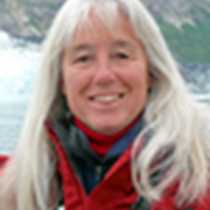Glacier Bay National Park
National Park Service Ranger/ Naturalist Janene Driscoll stepped onto the Sea Bird at 6:00am this morning. She spent the day with us sharing the dramatic story of Glacier Bay National Park: 3.3 million acres of outstanding scenic, historic, cultural and biological significance.
Our first pause was at Boulder Island where we observed sea otters. These charismatic animals have been resident in the park only since the mid-1990s. Our next stop was at South Marble Island, where black-legged kittiwakes, pigeon guillemots, common murres, glaucous-winged gulls, and the lovable tufted puffins were commencing their nesting activities. Steller sea lions lounged on smaller islets; their roars and growls joined with the calls of the birds to make quite a racket.
The land surrounding Glacier Bay is trying to loosen winter’s grip and emerge into spring. All of Southeast Alaska experienced the highest snowfall in over thirty years. Snow can still be seen down to sea level and deciduous trees and shrubs are reluctant to spread their new leaves. This creates a challenge for animals to find food. Some have remained in retreat for an extended period of time. Several bears and many mountain goats were at lower elevation where we had good views of them searching for food. One black bear had claimed possession of a skeleton of a mountain goat that had apparently fallen or was swept down from the heights by an avalanche. Two brown bears in Tidal Inlet looked quite healthy in spite of the difficult winter.
In the afternoon we reached the end of Tarr Inlet and met the contrasting faces of the Margerie and Grand Pacific Glaciers – the former bright and active, the latter dark and stagnant. Margerie Glacier pleased us with several calvings, which constantly alter the terminus of the glacier as the ice moves down from the mountains to tidewater. This was the northern extent of our journey into Glacier Bay. We now turned to cruise back toward the mouth, passing by two more tidewater glaciers – Lamplugh and Reid.
After dinner we had a chance to get off the ship at Bartlett Cove and stretch our legs on the forest loop trail through the young trees that have grown up on the glacial outwash over the last 200 years. Below the alpenglow-highlighted peaks of the Fairweather Range, we could make out a moose on the far shore of the cove, and our day of spectacular scenery and wildlife was complete.
National Park Service Ranger/ Naturalist Janene Driscoll stepped onto the Sea Bird at 6:00am this morning. She spent the day with us sharing the dramatic story of Glacier Bay National Park: 3.3 million acres of outstanding scenic, historic, cultural and biological significance.
Our first pause was at Boulder Island where we observed sea otters. These charismatic animals have been resident in the park only since the mid-1990s. Our next stop was at South Marble Island, where black-legged kittiwakes, pigeon guillemots, common murres, glaucous-winged gulls, and the lovable tufted puffins were commencing their nesting activities. Steller sea lions lounged on smaller islets; their roars and growls joined with the calls of the birds to make quite a racket.
The land surrounding Glacier Bay is trying to loosen winter’s grip and emerge into spring. All of Southeast Alaska experienced the highest snowfall in over thirty years. Snow can still be seen down to sea level and deciduous trees and shrubs are reluctant to spread their new leaves. This creates a challenge for animals to find food. Some have remained in retreat for an extended period of time. Several bears and many mountain goats were at lower elevation where we had good views of them searching for food. One black bear had claimed possession of a skeleton of a mountain goat that had apparently fallen or was swept down from the heights by an avalanche. Two brown bears in Tidal Inlet looked quite healthy in spite of the difficult winter.
In the afternoon we reached the end of Tarr Inlet and met the contrasting faces of the Margerie and Grand Pacific Glaciers – the former bright and active, the latter dark and stagnant. Margerie Glacier pleased us with several calvings, which constantly alter the terminus of the glacier as the ice moves down from the mountains to tidewater. This was the northern extent of our journey into Glacier Bay. We now turned to cruise back toward the mouth, passing by two more tidewater glaciers – Lamplugh and Reid.
After dinner we had a chance to get off the ship at Bartlett Cove and stretch our legs on the forest loop trail through the young trees that have grown up on the glacial outwash over the last 200 years. Below the alpenglow-highlighted peaks of the Fairweather Range, we could make out a moose on the far shore of the cove, and our day of spectacular scenery and wildlife was complete.




